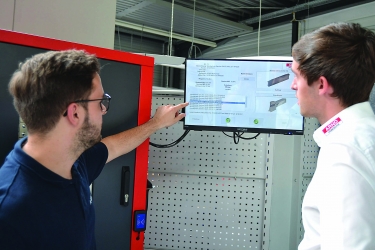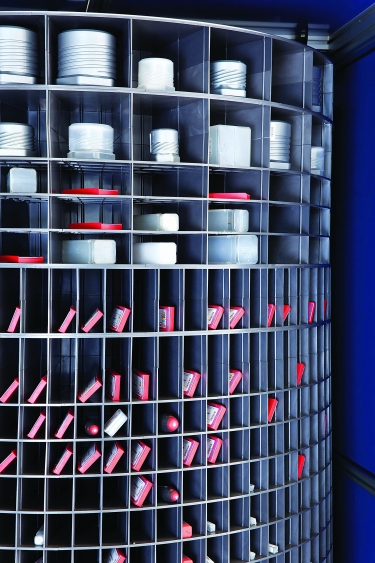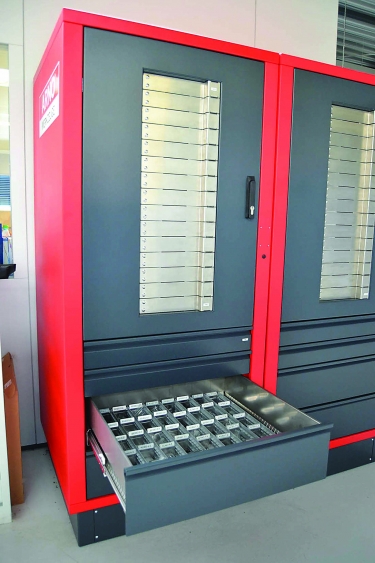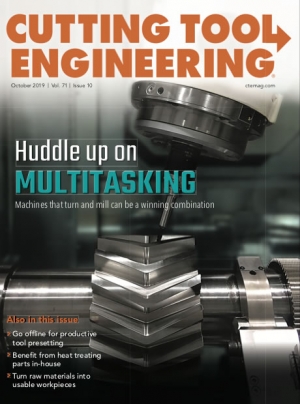“Where’s the tool? Who hasn’t put it back in the right place? There must be another one somewhere.” This is how Alexander Böthel from Adelmann Metallbearbeitung GmbH described the banter that was almost a daily occurrence and made work unnecessarily difficult. But that changed in February 2018.
Adelmann, Boxberg, Germany, is a contract manufacturer that specializes in the laboratory equipment sector using CNC turning and milling, waterjet cutting and other processes. The company manufactures prototypes, single parts, small batches and large-volume runs of up to 5,000 units in diameters up to 240mm.
Adelmann purchases some of its cutting tools from Arno-Werkzeuge Karl-Heinz Arnold GmbH, Ostfildern, Germany. (Arno-Werkzeuge USA LLC is in Harvard, Illinois.)

Adelmann’s Alexander Böthel (left) and Arno’s Simon Lang are in frequent contact and quickly resolve questions about the StoreManager Duo tool management system. Image courtey of Arno-Werkzeuge Karl-Heinz Arnold
Since its start in a garage in 2001, Adelmann has grown to occupy a 2,000-sq.-m facility. The increase in business and additions to the machine pool resulted in a considerable buildup in the number of tools. However, this also meant a drastic rise in tool search times. Furthermore, tools were stored in a locked cabinet. When an employee required a new tool, the foreman had to unlock the cabinet and issue the tool accordingly.
“The employee had to explain what job he wanted the tool for,” Böthel said. “It was bothersome for both the employee and for us foremen. But it was the only possibility to keep at least a little control over the use and location of tools.”
Stocks had to be updated by hand in a list to keep track of items, he added. Twice a month, the cabinets were checked, which took about two hours each time. Machines were frequently down when the right tool was not available. Even test gauges and thread gauges went missing. As a workaround, tables were posted on a magnet board to indicate the location of test equipment. But this method was prone to error.
A change was therefore urgently needed. Adelmann determined that a tool management system was the best solution. Three suppliers presented systems. The choice was made after a visit to Arno-Werkzeuge to see the flexibility of its StoreManager Duo.
The carousel system has over 360 individual compartments combined with four large drawers for managing measuring equipment and bigger items. The other suppliers did not have this capability. The system stores and reorders tools from Arno, as well as other suppliers.


The StoreManager Duo combines a carousel system for small parts with a drawer system for larger items. Image courtey of Arno-Werkzeuge Karl-Heinz Arnold
Arno offers its latest StoreManager Duo model through a lease purchase agreement, which allows Adelmann to test the system for two years to see whether it meets the company’s needs. The monthly rent includes service and maintenance costs, and a free hotline is available to respond to urgent questions.
Arno and Adelmann have collaborated for about 10 years. The level of trust between the companies is high, especially in the advice from Simon Lang, Arno’s sales engineer for tool management systems.
Besides time savings, the main argument in favor of a tool management system is tool traceability. Every employee can check tool availability and location on the system’s cabinet or a networked PC. The StoreManager Duo can assign various rights to each employee.
The constant availability of tools is another advantage that boosts productivity. For example, if a tool breaks, an employee can fetch a tool from the system at any time.
Since the system was introduced, a lot has changed about restocking. If the stock level drops below a predefined minimum quantity, Böthel receives a message. Once a week, he checks the order proposals and sends the prepared orders.
“Although I still have to order by hand, the whole thing hardly takes five minutes,” he said. “It’s an enormous work saving.”
The next step is automated order dispatch. The system at Adelmann works autonomously, meaning that communication is via email or an online shop. “However, it can be connected to the ERP system at any time,” Lang said. “Data is then transferred by CSV file.”
The storage times and replacement cycles of individual tools indicate whether they should continue to be stored and reordered in the StoreManager or relocated to an open long-term store.
Storage times also signify where potential savings can be made, what tools are used most and where tests for new tools make no sense at all.
“Storing certain data in the system—for example, cutting data for specific materials—is absolutely no problem and is an additional service,” Lang said. “It’s a simple aid that really helps employees.”
“It saves time in work planning, work preparation and programming; it makes for a smoother workflow,” Böthel said, adding that it ensures reliable work processes in advance and that costs are easier to calculate.
Initially, the number of different tools was grossly underestimated. It did not take long to fill all 360-plus compartments and four drawers. Adelmann had thought one cabinet would be enough but quickly determined that was way off and purchased a second unit. A master cabinet with a monitor can connect to and manage two additional cabinets.
After six months in use, there were only 16 locations free on the carousel and two free drawers. If Adelmann ever wants to upgrade to the StoreManager Pro with up to 2,160 carousel compartments, it would be simple to transfer all the previous data and processes, according to Arno. All systems have equal access to the SQL database. Even an expansion at a different location would pose no difficulty.
“An employee who cannot find a drill in his local StoreManager can send a request over the system (to learn) whether the drill is stocked in one of the other StoreManagers in the network,” Lang said.
Contact Details
Related Glossary Terms
- computer numerical control ( CNC)
computer numerical control ( CNC)
Microprocessor-based controller dedicated to a machine tool that permits the creation or modification of parts. Programmed numerical control activates the machine’s servos and spindle drives and controls the various machining operations. See DNC, direct numerical control; NC, numerical control.
- gang cutting ( milling)
gang cutting ( milling)
Machining with several cutters mounted on a single arbor, generally for simultaneous cutting.
- milling
milling
Machining operation in which metal or other material is removed by applying power to a rotating cutter. In vertical milling, the cutting tool is mounted vertically on the spindle. In horizontal milling, the cutting tool is mounted horizontally, either directly on the spindle or on an arbor. Horizontal milling is further broken down into conventional milling, where the cutter rotates opposite the direction of feed, or “up” into the workpiece; and climb milling, where the cutter rotates in the direction of feed, or “down” into the workpiece. Milling operations include plane or surface milling, endmilling, facemilling, angle milling, form milling and profiling.
- turning
turning
Workpiece is held in a chuck, mounted on a face plate or secured between centers and rotated while a cutting tool, normally a single-point tool, is fed into it along its periphery or across its end or face. Takes the form of straight turning (cutting along the periphery of the workpiece); taper turning (creating a taper); step turning (turning different-size diameters on the same work); chamfering (beveling an edge or shoulder); facing (cutting on an end); turning threads (usually external but can be internal); roughing (high-volume metal removal); and finishing (final light cuts). Performed on lathes, turning centers, chucking machines, automatic screw machines and similar machines.
- waterjet cutting
waterjet cutting
Fine, high-pressure (up to 50,000 psi or greater), high-velocity jet of water directed by a small nozzle to cut material. Velocity of the stream can exceed twice the speed of sound. Nozzle opening ranges from between 0.004" to 0.016" (0.l0mm to 0.41mm), producing a very narrow kerf. See AWJ, abrasive waterjet.
End User
Adelmann Metallbearbeitung GmbH
+07930-99-22-0-0
www.adelmann-metallbearbeitung.de/02/home.html
Solution Provider
Arno-Werkzeuge USA LLC
815-943-4426
www.arnousa.com
Challenge
Reduce the time spent searching for cutting tools and other machining-related products.
Solution
A tool management system.


